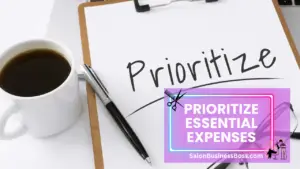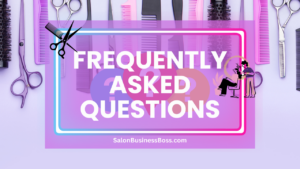The hair industry stands as a testament to human creativity and ingenuity. Starting a hair business can be an exciting venture, promising a blend of artistic expression and entrepreneurial achievement. However, beneath the glamour and allure lie the essential considerations of costs that every aspiring hairpreneur must navigate.
Here are some key factors that influence the cost of starting a hair business: location expenses, inventory investment, marketing efforts, personnel salaries, and regulatory fees. Planning wisely ensures a solid financial foundation.
In this article, we’ll delve into the various factors that contribute to the cost of launching a hair business and provide insights into budgeting effectively.
The Spectrum of Hair Businesses
The hair industry is a vast and diverse landscape, ranging from salons and barber shops to hair extensions, wigs, and hair care product lines. The costs associated with starting a hair business can vary significantly depending on the type of venture you’re pursuing. For instance, setting up a physical salon will entail different expenses compared to launching an online store for hair extensions.
Infrastructure Costs

When considering a physical hair salon or barber shop, it’s important to acknowledge the substantial role of infrastructure expenses in your startup funds. These expenses include renting or buying a suitable space, crafting an appealing interior, obtaining salon furniture, and acquiring necessary equipment like chairs, mirrors, and hairdryers. Costs in this category span a broad range, depending on the scale of your venture.
Smaller setups may require a few thousand dollars, while more upscale establishments in prime locations can demand investments reaching six figures. The choice of location, interior design, and equipment quality all contribute to the overall financial outlay. Therefore, comprehending these infrastructure costs is essential as you outline your budget, enabling you to make informed decisions tailored to your business’s specific needs and aspirations.
Read more about: The Science of Salon Productivity: Hair Salon Floor Plan Layouts
Inventory Investment
In the realm of hair businesses, products like hair extensions, wigs, and specialized hair care items take center stage. Your initial investment in inventory hinges on the variety and quality of products you plan to provide. Establishing connections with reliable suppliers and curating a diverse collection might necessitate a significant upfront expenditure. This inventory forms the core of your business and plays a pivotal role in its operations. Balancing the scope of your offerings with your available budget is of utmost importance.
By striking this equilibrium, you ensure that your customers have a range of choices while also managing your financial resources wisely. In essence, your inventory investment shapes the foundation of your hair business, influencing customer satisfaction and the potential for growth. Understanding the connection between your product range, the quality of items, and your budget is key to making informed decisions that lead to a solid launch.
Online Presence
In today’s digital era, having an online presence is essential. This involves building a polished website, participating in social media marketing, and putting resources into e-commerce platforms. These elements are vital when you’re setting up an online hair business. Although these expenses might be less compared to physical infrastructure costs, they hold immense importance. They play a significant role in expanding your reach to a broader audience and constructing a recognizable brand identity.
While they might not demand the same financial commitment as establishing a physical space, they’re nonetheless crucial investments in connecting with potential customers, engaging with them on various platforms, and ensuring your business is easily discoverable online. This online presence acts as your virtual storefront, making it convenient for customers to explore your offerings and boosting your brand’s visibility in the digital landscape.
Marketing and Promotion
Crafting a brand and drawing in customers necessitates well-devised marketing approaches. This involves strategies like initiating promotional campaigns and joining local events. However, it’s important to realize that marketing costs can accumulate rapidly. To manage this, allocate a section of your budget to cover both online and offline marketing endeavors. This ensures your hair business becomes more visible to potential customers.
By investing in marketing, you’re essentially amplifying your business’s voice, making it heard in a crowded marketplace. While it’s easy to underestimate the significance of these expenses, they’re the means by which you introduce your products and services to the public, create a compelling brand story, and establish connections with your target audience. Ultimately, these strategies work in tandem to boost your hair business’s presence, allowing you to effectively communicate what you offer and why customers should choose you over competitors.
Personnel and Training

When it comes to salons and barber shops, employee wages and training expenses hold crucial importance. The proficiency and professionalism of your team play a substantial role in shaping your business’s standing. Allocating resources to training initiatives has far-reaching benefits. It enhances your staff’s capabilities, allowing them to better serve customers, execute complex hair treatments, and provide top-notch services. Furthermore, investing in training reflects positively on the experiences of your customers. They are more likely to return when they receive skillful and courteous service.
Remember, your employees are the face of your business, representing your brand to every customer who walks through the door. By focusing on their training and development, you’re not only investing in their growth but also in the long-term growth of your hair business. With skilled and well-trained staff, you build a foundation of customer trust and satisfaction, which in turn contributes to the growth of your salon or barber shop.
Read more about: The Variability of Profit Margins in Hair Salons
Regulatory and Licensing Fees
Ensuring adherence to local rules and obtaining the required licenses is a pivotal aspect of commencing any business. These regulatory and licensing fees stand as essential components that demand your attention. The expenses associated with them can fluctuate based on where your business is situated. Therefore, it’s imperative to incorporate these fees into your financial planning. Neglecting this aspect can lead to unexpected financial strains and delays in getting your hair business off the ground.
These fees, while not as immediately visible as other expenses, are fundamental to establishing your business legally and smoothly. They’re essentially the official stamp of approval that allows you to operate within the bounds of the law, protecting both you and your customers. Acknowledging these regulatory and licensing fees upfront empowers you to create a budget that is comprehensive and well-prepared, setting you on a path to a compliant and hassle-free business launch.
Miscellaneous Expenses
Apart from the primary categories we’ve discussed, there are smaller yet noteworthy expenses that might slip your mind but are equally essential. These expenses, falling under miscellaneous costs, encompass a range of items that can impact your budget. They include expenses such as utilities to keep your business running smoothly, insurance to safeguard against unexpected incidents, subscriptions to necessary software for operational efficiency, and even unforeseen costs that may crop up unexpectedly. While these expenses might not immediately stand out, they can accumulate over time and affect your overall financial plan. It’s important to remember that even seemingly minor expenses can have a collective impact on your budget’s stability. By accounting for these miscellaneous costs, you ensure that your budget is comprehensive and well-prepared to handle the full scope of financial demands that come with launching and sustaining a hair business.
Budgeting Strategies and Cost Management
Now that we’ve outlined the major expenses associated with starting a hair business, let’s discuss some budgeting strategies to ensure your entrepreneurial journey begins on a solid financial foundation:
Thorough Research
Before you set out on your business journey, it’s crucial to dedicate time to thorough research. This means delving deep into understanding several aspects. First, you need to grasp the demand in the market – what do customers want and need? Second, take a close look at your competition. Who are they, what are they offering, and what sets you apart? Consider pricing strategies. What are customers willing to pay, and how does your pricing compare to what’s already out there? This research isn’t just about gathering information, it’s about gaining insights that’ll guide your decisions.
Armed with this knowledge, you can determine the kind and quality of products to offer, ensuring you’re meeting customer needs while also standing out in the marketplace. It’s like laying a strong foundation for your business – the more you know, the better your decisions will be, and the more likely you are to build something that truly resonates with customers.
Prioritize Essential Expenses

It’s quite tempting to go all out and create a grand salon or a wide array of products right from the start. However, it’s wiser to begin by focusing on what’s truly necessary. Consider these essential expenses as your foundation. Just like when you’re building a house, you need a solid base before you add the fancy stuff. Start with the things that are crucial for your business to function – like your core services or products. Once you’ve got that foundation set and your business starts to gain traction, you can then start expanding your offerings.
This gradual approach not only helps you manage your budget more effectively but also lets you learn and adapt as you go along. It’s like growing a plant – you give it a strong start with the basics before you nurture it to flourish. So, while it’s exciting to think big, remember that starting with the essentials is a smart strategy for building a sturdy and sustainable business.
Read more about: Top 15 Salon Marketing Ideas to Attract Your Ideal Clients
Consider Financing Options
If your personal savings don’t cover your business budget, you might want to think about different ways to get the money you need. One option is looking into things like small business loans or teaming up with partners who can invest in your idea. These choices could provide the financial support required to kickstart your business. However, it’s wise to approach these options cautiously, especially when you’re just beginning.
Think of debt like borrowing money that you have to pay back, often with extra charges. Accumulating too much debt right at the start can burden your business. It’s like carrying a heavy load that slows you down on your journey. So, while financing avenues can be beneficial, ensure you’re mindful of how much you borrow and how it aligns with your overall strategy. Just like you’d make careful decisions for a long journey, make deliberate choices about your business’s financial path.
Track Expenses
Maintaining a thorough record of all your expenses, even the tiny ones, is incredibly valuable. Think of it as creating a map that shows you exactly where your money is going. This map helps you spot places where you might be spending more than needed, areas where you could shift resources around, or even points where you can change how you’re pricing things. It’s like having a flashlight that reveals all the hidden corners of your financial landscape.
By knowing where your money is flowing, you can make informed decisions about your business’s financial direction. Just as you wouldn’t go on a journey without a clear sense of where you’re headed, having a clear view of your expenses guides your business journey in a smart and strategic way. It’s about ensuring you’re on the right path toward financial stability and growth.
Plan for Contingencies
Expect the unexpected – that’s a rule of the entrepreneurial game. Sometimes, surprise expenses pop up out of nowhere, and that’s completely normal. It’s like when you’re on a road trip, and suddenly you need to fix a flat tire. To handle these surprises, having a contingency fund is like having a spare tire in your trunk. It’s money you set aside specifically for these unplanned moments. Just as you’re prepared for bumps in the road, having a financial cushion lets you handle unexpected costs without derailing your plans.
It’s a bit like having an umbrella on a cloudy day – you might not use it often, but it’s great to have when the rain starts unexpectedly. So, when you’re budgeting for your hair business, remember to include this cushion. It’s not just about dollars; it’s about being prepared and having the peace of mind that you’re ready for whatever comes your way in the journey of entrepreneurship.
Conclusion
Starting a hair business is a journey that requires a blend of creativity, determination, and sound financial planning. While the costs can be significant, they are investments that pave the way for a fulfilling venture. By understanding the various expenses involved and adopting strategic budgeting practices, aspiring hairpreneurs can embark on their entrepreneurial journey with confidence. Remember, it’s not just about dollars and cents; it’s about transforming a passion for hair into a thriving business that brings joy and confidence to customers worldwide.
Frequently Asked Questions

Q: What are the typical expenses involved in starting a hair business?
A: Starting a hair business entails various costs, including infrastructure expenses (if physical), inventory investment, marketing and promotional efforts, employee salaries, regulatory and licensing fees, and miscellaneous expenditures. Proper budgeting is crucial for an outstanding launch.
Q: How can I budget effectively for my hair business startup?
A: To budget effectively, conduct thorough market research, prioritize essential expenses, consider financing options, track all expenditures meticulously, and create a contingency fund for unexpected costs. Careful planning ensures a balanced financial approach to launching your business.
Q: Are there different costs associated with an online hair business versus a physical salon?
A: Yes, there are differences. For an online hair business, expenses focus on building a professional website, digital marketing, and e-commerce platforms. Physical salons involve infrastructure costs, interior design, equipment, and possibly higher overhead. Understanding these distinctions helps tailor your budgeting strategy.
To learn more on how to start you own salon checkout my startup documents here.
The information provided by SalonBusinessBoss.com (“The Site”) is for general informational purposes only. All information on the Site is provided in good faith, however, we make no representation or warranty of any kind, express or implied, regarding the accuracy, adequacy, validity, reliability, availability or completeness of any information on the Site. Under no circumstance shall we have any liability to you for any loss or damage of any kind incurred as a result of the use of the Site or Reliance on any information provided on the Site. Your use of the Site and your reliance on any information on the Site is solely at your own risk. This blog post is for educational purposes only and does not constitute legal advice. Please consult a legal expert to address your specific needs. Terms and Conditions. (https://salonbusinessboss.com/terms-conditions/)

About the author. Entrepreneur and Salon Business Fan.
Hi! I am Shawn and I am a happy individual who happens to be an entrepreneur. I have owned several types of businesses in my life from a coffee shop to an import and export business to an online review business plus a few more and now I create online salon business resources for those interested in starting new ventures. It’s demanding work but I love it. I do it for those passionate about their business and their goals. That’s why when I meet a salon business owner, I see myself. I know how hard the struggle is to retain clients, find good employees and keep the business growing all while trying to stay competitive.
That’s why I created Salon Business Boss: I want to help salon business owners like you build a thriving business that brings you endless joy and supports your ideal lifestyle.

